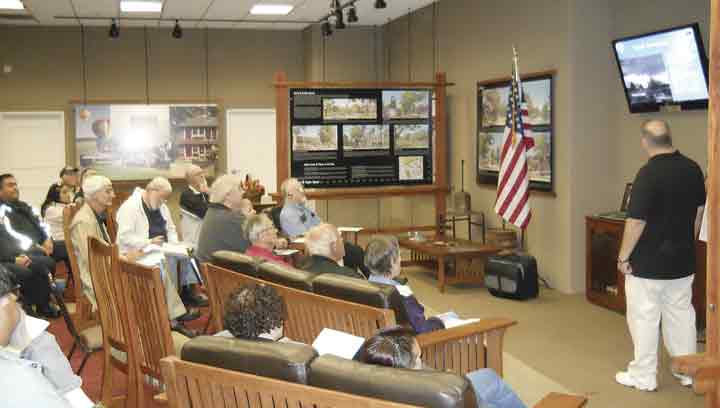
|
Those fascinated by the weather found they can combine sky-watching with volunteerism at the February 16 Severe Weather Spotter training. According to Santa Paula Fire Captain Steve Lazenby, the city’s Emergency Preparedness coordinator, the session - sponsored by Santa Paula Citizens Corps and the National Weather Service - drew a good crowd to the Limoneira Pavilion. |
NWS Weather Spotter training combines sky-watching with volunteerism
March 16, 2011
By Peggy Kelly
Santa Paula News
Those fascinated by the weather found they can combine sky-watching with volunteerism at the February 16 Severe Weather Spotter training. According to Santa Paula Fire Captain Steve Lazenby, the city’s Emergency Preparedness coordinator, the session - sponsored by Santa Paula Citizens Corps and the National Weather Service - drew a good crowd to the Limoneira Pavilion.
“The Weather Spotter training went very well,” said Lazenby. “There were more than 25 people in attendance and the overwhelming response was that it was well worth attending.”
Many people love looking at clouds, rush to their rain gauge during storms, check weather updates online and have one ear glued to the television during serious events. And because the National Weather Service needs volunteers to help with “on the ground” weather observation, the Severe Weather Spotter program was created.
The trainer for the February 16 session was Joe Sirard, a National Weather Service meteorologist and a Santa Paula resident. Lazenby said the training also allows those who complete it and undergo a minor background check to become certified Severe Weather Spotters.
Lazenby said those who complete the training “become part of your community’s early detection system. These sessions are most appropriate for individuals who work in public safety,” whether in emergency management, police, fire, public works, schools, hospitals, nursing homes or daycare facilities, “but anyone who is interested is encouraged to become a certified Weather Spotter.”
Attendees at the February 16 training learned how to become an “integral part of a community’s frontline, early weather warning system. They learned why spotters are needed, severe weather terminology, what to report and severe weather safety.”
Weather Spotters learned about cloud shapes and their meanings, how to identify the different types of water flow and early warnings of flooding incidents, and how to describe the size of hail when reporting events to the National Weather Service, among other subjects. The presentation is formatted to outline the types of weather conditions that may develop into severe situations and thus need to be relayed to the National Weather Service and local warning communication systems.
Lazenby noted that while more effective technology becomes available every day to help forecast approaching severe weather, “It is still the trained eyes on the sky that are needed to give that precious warning time so vital to save lives. The more people are trained, the more efficient the warning network becomes. The weather service can know it’s hailing but not how big the hail is, they can see a storm coming, but it is the shape of the cloud that can determine just how severe the storm might be; they have to be told water is rising and flooding seems imminent... it’s really fascinating how much the person in the street can help out by reporting what they are observing” during weather events.
Upon completion of the training, attendees were invited to apply to become certified Weather Spotters. When approved they will receive their numerical identification used for reporting weather incidents directly to the National Weather Service.
For more information call 805-933-4297 and leave a message, or email Lazenby at slazenby@spcity.org.



